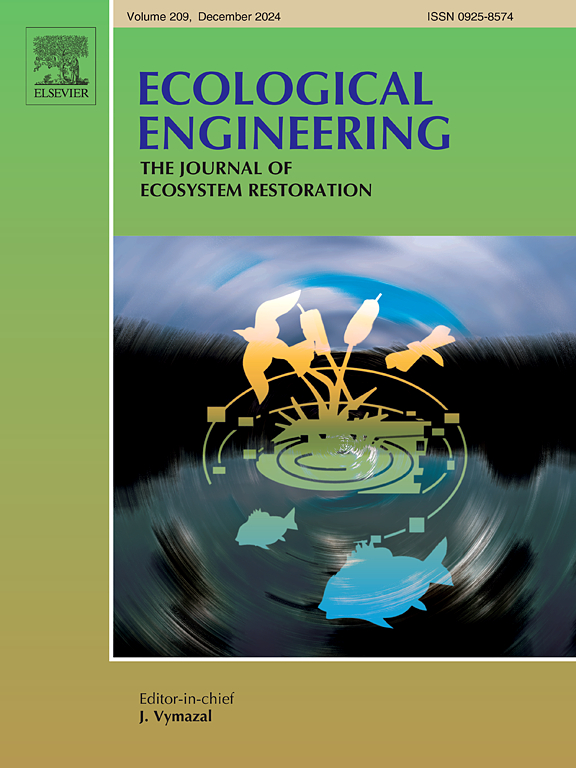How anthropogenic modification of riverscapes reduces the resilience of floodplain water bodies to drought
IF 4.1
2区 环境科学与生态学
Q1 ECOLOGY
引用次数: 0
Abstract
Between 2018 and 2023, central Europe experienced a series of droughts—one manifestation of climate change expected to increase in frequency in the future. These events increasingly expose aquatic ecosystems, such as floodplain water bodies, to hydrological extremes. Simultaneously, anthropogenic river modifications like channelization and diking have been progressively disconnecting semi-aquatic ecosystems from the main river. Here, we examined how drought and hydromorphological modifications affect the water quality of floodplain water bodies.
Specifically, we investigated 36 floodplain water bodies near the Elbe River in Germany and analyzed water samples from spring and late summer 2022. We assessed connectivity (past frequency of surface connection to the stream) and effects of drought (evaporation measured by changes in stable water isotopes) using a scoring system. This system evaluated impairment and habitat loss, allowing us to quantify the impact of hydrological disconnection on floodplain water bodies.
Severe impacts, including low surface oxygen (<3 mg/L), products of anaerobic decomposition, fish kills, and dry-outs, primarily affected water bodies with low connectivity (<10 %). Multiple linear regression linked low connectivity and high evaporation to habitat degradation (r2 = 0.487, p < 0.001). Furthermore, dissolved oxygen concentrations increased with increasing chlorophyll a in connected lakes (p < 0.001), as expected, but no relationship was observed in disconnected lakes (p = 0.626). We attribute this lack of correlation to the decomposition of fine-grained organic sediments that have not been resuspended and flushed out in disconnected lakes. We conclude that river modifications for navigation reduce floodplain resilience to droughts, amplifying the effects of climate change on semi-aquatic ecosystems.
人为改变河景如何降低洪泛区水体对干旱的适应能力
2018年至2023年期间,中欧经历了一系列干旱,这是气候变化的一个表现,预计未来气候变化的频率会增加。这些事件使洪泛平原水体等水生生态系统日益暴露于极端水文环境。与此同时,人为的河流改造,如渠化和筑堤,已经逐渐将半水生生态系统与主河分离。本文研究了干旱和水文形态变化对漫滩水体水质的影响。具体来说,我们调查了德国易北河附近的36个漫滩水体,并分析了2022年春季和夏末的水样。我们使用评分系统评估了连通性(过去地表与河流连接的频率)和干旱的影响(通过稳定水同位素变化测量的蒸发)。该系统评估了损害和栖息地的丧失,使我们能够量化水文断流对洪泛平原水体的影响。严重的影响,包括低表面氧(3mg /L)、厌氧分解产物、鱼类死亡和干涸,主要影响低连通性的水体(10%)。多元线性回归将低连通性和高蒸发与生境退化联系起来(r2 = 0.487, p <;0.001)。此外,溶解氧浓度随叶绿素a的增加而增加(p <;0.001),但在不相连的湖泊中没有观察到相关(p = 0.626)。我们将这种相关性的缺乏归因于细粒有机沉积物的分解,这些沉积物没有在断开的湖泊中重新悬浮和冲刷出来。我们的结论是,河道改道降低了洪泛区对干旱的适应能力,放大了气候变化对半水生生态系统的影响。
本文章由计算机程序翻译,如有差异,请以英文原文为准。
求助全文
约1分钟内获得全文
求助全文
来源期刊

Ecological Engineering
环境科学-工程:环境
CiteScore
8.00
自引率
5.30%
发文量
293
审稿时长
57 days
期刊介绍:
Ecological engineering has been defined as the design of ecosystems for the mutual benefit of humans and nature. The journal is meant for ecologists who, because of their research interests or occupation, are involved in designing, monitoring, or restoring ecosystems, and can serve as a bridge between ecologists and engineers.
Specific topics covered in the journal include: habitat reconstruction; ecotechnology; synthetic ecology; bioengineering; restoration ecology; ecology conservation; ecosystem rehabilitation; stream and river restoration; reclamation ecology; non-renewable resource conservation. Descriptions of specific applications of ecological engineering are acceptable only when situated within context of adding novelty to current research and emphasizing ecosystem restoration. We do not accept purely descriptive reports on ecosystem structures (such as vegetation surveys), purely physical assessment of materials that can be used for ecological restoration, small-model studies carried out in the laboratory or greenhouse with artificial (waste)water or crop studies, or case studies on conventional wastewater treatment and eutrophication that do not offer an ecosystem restoration approach within the paper.
 求助内容:
求助内容: 应助结果提醒方式:
应助结果提醒方式:


